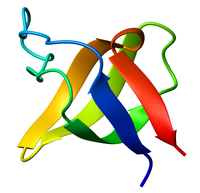| SH3 domain | |||||||||
|---|---|---|---|---|---|---|---|---|---|
 Ribbon diagram of the SH3 domain, alpha spectrin, from chicken (PDB accession code 1SHG), colored from blue (N-terminus) to red (C-terminus). | |||||||||
| Identifiers | |||||||||
| Symbol | SH3_1 | ||||||||
| Pfam | PF00018 | ||||||||
| Pfam clan | CL0010 | ||||||||
| ECOD | 4.1.1 | ||||||||
| InterPro | IPR001452 | ||||||||
| SMART | SM00326 | ||||||||
| PROSITE | PS50002 | ||||||||
| SCOP2 | 1shf / SCOPe / SUPFAM | ||||||||
| CDD | cd00174 | ||||||||
| |||||||||
The SRC Homology 3 Domain (or SH3 domain) is a small protein domain of about 60 amino acid residues. Initially, SH3 was described as a conserved sequence in the viral adaptor protein v-Crk. This domain is also present in the molecules of phospholipase and several cytoplasmic tyrosine kinases such as Abl and Src.[1][2] It has also been identified in several other protein families such as: PI3 Kinase, Ras GTPase-activating protein, CDC24 and cdc25.[3][4][5] SH3 domains are found in proteins of signaling pathways regulating the cytoskeleton, the Ras protein, and the Src kinase and many others. The SH3 proteins interact with adaptor proteins and tyrosine kinases. Interacting with tyrosine kinases, SH3 proteins usually bind far away from the active site. Approximately 300 SH3 domains are found in proteins encoded in the human genome. In addition to that, the SH3 domain was responsible for controlling protein-protein interactions in the signal transduction pathways[6] and regulating the interactions of proteins involved in the cytoplasmic signaling.[7]
- ^ Pawson T, Schlessingert J (July 1993). "SH2 and SH3 domains". Current Biology. 3 (7): 434–42. doi:10.1016/0960-9822(93)90350-W. PMID 15335710. S2CID 53273571.
- ^ Mayer BJ (April 2001). "SH3 domains: complexity in moderation". Journal of Cell Science. 114 (Pt 7): 1253–63. doi:10.1242/jcs.114.7.1253. PMID 11256992.
- ^ Musacchio A, Gibson T, Lehto VP, Saraste M (July 1992). "SH3--an abundant protein domain in search of a function". FEBS Letters. 307 (1): 55–61. doi:10.1016/0014-5793(92)80901-R. PMID 1639195. S2CID 8564342.
- ^ Mayer BJ, Baltimore D (January 1993). "Signalling through SH2 and SH3 domains". Trends in Cell Biology. 3 (1): 8–13. doi:10.1016/0962-8924(93)90194-6. PMID 14731533.
- ^ Pawson T (February 1995). "Protein modules and signalling networks". Nature. 373 (6515): 573–80. doi:10.1038/373573a0. PMID 7531822. S2CID 4324726.
- ^ Schlessinger J (February 1994). "SH2/SH3 signaling proteins". Current Opinion in Genetics & Development. 4 (1): 25–30. doi:10.1016/0959-437X(94)90087-6. PMID 8193536.
- ^ Koch CA, Anderson D, Moran MF, Ellis C, Pawson T (May 1991). "SH2 and SH3 domains: elements that control interactions of cytoplasmic signaling proteins". Science. 252 (5006): 668–74. doi:10.1126/science.1708916. PMID 1708916.